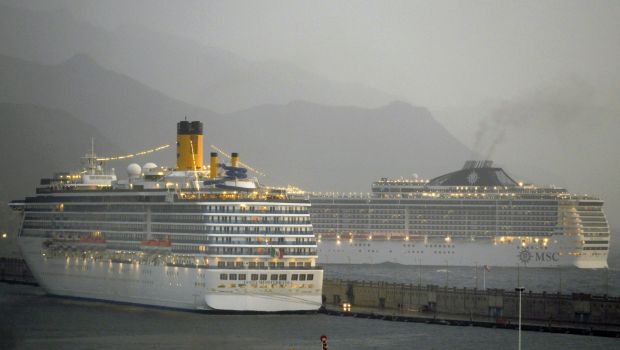
Fantasia cruise ship (R) sails next to Costa Mediterranea ship (L) on a cloudy day in Santa Cruz de Tenerife port, Canary Island, Spain, 11 December 2013 (EPA/CRISTOBAL GARCIA)
After competing for business in the last few years, Abu Dhabi and Dubai, both part of the seven-member United Arab Emirates, and neighboring Oman are now collaborating to promote the region as a cruise destination.
All three are investing in building additional cruise terminals or facilities and plan to establish common operational and technical standards, although visas and security issues remain sticking points that need to be improved or could limit growth in the industry.
“A joint approach to development will be key to ensuring we have a sustainable agenda for growth,” Sheikh Sultan bin Tahnoon Al Nahyan, chairman, Abu Dhabi Tourism & Culture Authority (TCA), told the Seatrade Middle East Cruise Forum on Wednesday.
The three Gulf states are formalizing a memorandum of understanding to jointly develop the cruise industry in the region, with others likely to join the alliance soon, two industry sources familiar with the matter told Reuters, declining to be named because the information is not yet public.
“It is an emerging cruise destination with positives such as winter sun destination, rich cultural heritage, beautiful islands, deserts and with no funding problem,” one of the sources said.
The biggest barrier to growth will be the issue of visas. The lack of a European-style Schengen single visa for entry into the six Gulf states and the absence of multi-entry visas are major stumbling blocks, executives of cruise liners told the forum.
“A Gulf-wide cruise visa would be ideal to attract more tourists due to the entry and exit into multiple ports, leading to reduced costs and less processing time,” said Grant Holmes, CEO of Progress International, a cruise consultancy.
“The Gulf is a promising market but a clear short to medium-term strategy is needed soon from all the Gulf states after forming an alliance to work together to promote the region.”
Dubai, the Gulf’s tourism hub and a duty-free shopping destination, is expanding its cruise terminal by mid-2014 to handle five cruise ships simultaneously, said Hamad Mohammed bin Mejren, executive director of Dubai’s department of tourism & commerce marketing.
“The economic impact of this industry has been steadily growing,” he said, adding that the emirate hosted 407,000 cruise passengers last year, compared with just 7,000 in 2001.
Abu Dhabi had 180,000 passengers in the last cruise season and expects 220,000 passengers on 80 vessels this season.
The capital of the United Arab Emirates, which is investing billions of dollars in tourism to build museums such as the Louvre and Guggenheim, is building a new permanent cruise terminal to handle three to four cruise ships at a time. It is also developing facilities on two nearby islands—Delma and Sir Baniyas—for cruise tourists, Mohammed Al Dhaheri, Strategy & Policy Director, TCA Abu Dhabi, said.
Oman, which drew more than 300,000 cruise passengers in the last season, has approved plans for a new terminal at the port of Muttrah, one of three ports open to cruise vessels, Salim bin Aday Al-Mamari, director-general of tourism development, told the forum.
Qatar and Bahrain are also emerging cruise destinations with several liners calling at their ports.
With the region gearing up for two major global events—Expo 2020 in Dubai and the FIFA world cup in Qatar in 2022, tourism is set to increase.
Political turmoil and violence elsewhere in the Middle East, however, puts the Gulf firmly at a disadvantage compared to cruise destinations such as the Caribbean and Gulf states need to do more to convince tourists that their countries are safe for travel.
Temperatures that can top 40 C in the summer months in the Gulf are another handicap.
“Safety and security is critical for all liners as well as guests and work needs to be done to dispel the perception of regional instability,” said Holmes at Progress international.
